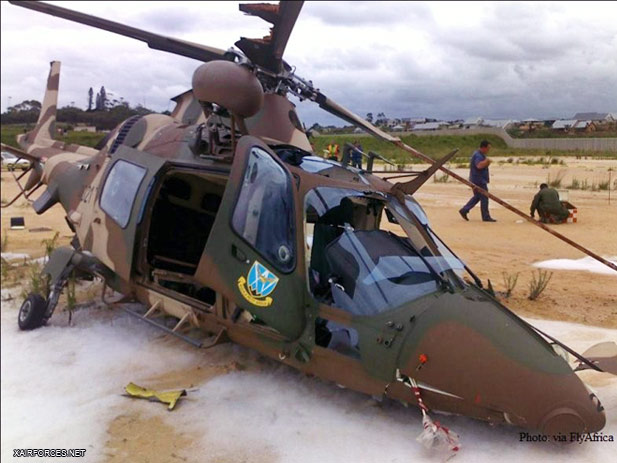
South African Air Force reveals cause of A109 crashes

The three A109 Light Utility Helicopter crashes were caused by mechanical failure and pilot error, but all technical problems have been resolved, the chief of the South African Air Force has said.
Lieutenant General Carlo Gagiano was speaking to journalists at the Air Force Day parade held at Swartkop on Friday.
"All problems have been identified and rectified," Gagiano said, adding that Air Force technicians went through all the A109's systems and checked all parts to isolate the problems. Since entering service around five years ago, the A109 fleet has been subject to several engineering changes.
On May 12, 2009, an A109 crashed into Woodstock Dam, near Bergville in Kwazulu-Natal. All three crewmembers on board died (Lieutenant Simon Baloyi, 27, Flight Sergeant Moné Zuidmeer, 32, and Captain Bongani Mdluli, 34). The aircraft was in formation with two other A109s en route from Swartkop to Dragon Peak Park in the Bergville area to take part in a scheduled weeklong mountain training exercise. The formation was in nap-of-the-earth flight at the time. Gagiano said the crash was judged to be caused by pilot error, as it is 'dangerous' flying over flat water that reflects the sky.
Another two helicopters were damaged in November and December 2010, but with no loss of life. On December 15, 2010, an A109 made an emergency landing near Ballito on the KwaZulu-Natal north coast while assisting the police and Business Against Crime.
"During the flight, the pilot lost control of the helicopter and had to execute an emergency landing. There were no serious injuries reported, but the commander of the aircraft and a civilian were taken to the Ballito Hospital for observation," the SANDF said. The rotorcraft was carrying a crew of two and two passengers.
Another A109 was badly damaged in a hard landing near Potchefstroom in the Northwest Province in November 2010. The crew were not seriously injured. Following the December crash, all the A109s were grounded, pending inspection.
Gagiano said that the cause of one of the 2010 crashes was due to tail rotor failure while the other crash was caused when a swash plate control rod broke, but that all mechanical problems have been solved.
The A109 LUH was purchased to replace the elderly Eurocopter SA-316/SA-319 Alouette III helicopters, which had been in service since 1962 in the light utility role. Delivery of the 30 A109 helicopters purchased from the Anglo-Italian AgustaWestland helicopter company under the R2.4 billion Project Flange commenced on October 19, 2005. Deliveries were beset with delays and difficulties and an option for a further ten was not exercised.
The SAAF required the type to take pressure off its Denel Oryx medium utility fleet. The Air Force has long had the need for a platform more capable than the Alouette III but less expensive and more efficient than the Oryx for the bulk of taskings. The A109 was expected to fill that niche.
Although the first five A109 aircraft were manufactured in Italy, the balance of the 25 helicopters was assembled by Denel Saab Aerostructures. By 2008 deliveries were four years late, leading to the imposition of a R90 million penalty, the only one imposed under the "arms deal". It has been reported that offsets were tardy and the platform has failed to live up to expectations - one criticism is that it is underpowered.
Source: Guy Martin, 30 January 2012 - The South African Air Force News & Events - Attrition (www.saairforce.co.za)
Photo: The South African Air Force (SAAF) A109 crashes (Photo by fly Africa)
(30.01.2012)
|